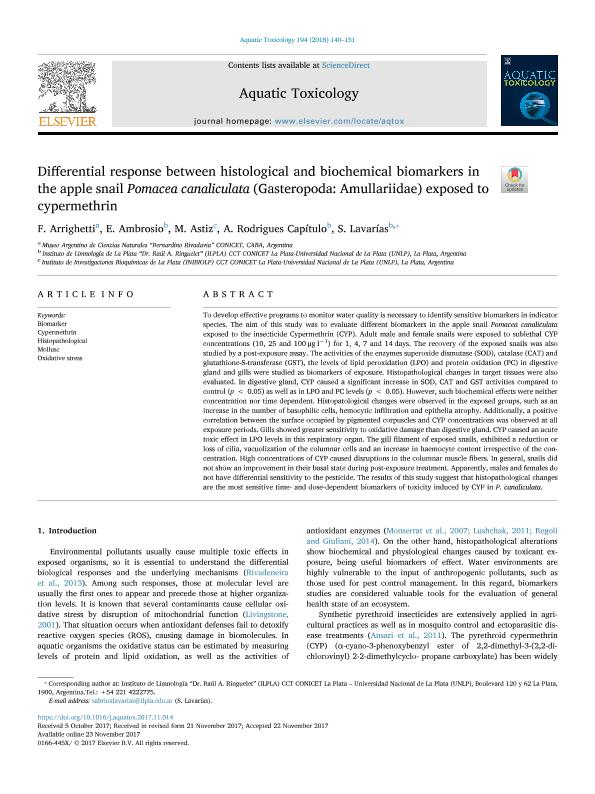Mostrar el registro sencillo del ítem
dc.contributor.author
Arrighetti, Florencia

dc.contributor.author
Ambrosio, Eugenia Soledad

dc.contributor.author
Astiz, Mariana

dc.contributor.author
Rodrigues Capitulo, Alberto

dc.contributor.author
Lavarias, Sabrina Maria Luisa

dc.date.available
2019-10-08T15:53:55Z
dc.date.issued
2018-01
dc.identifier.citation
Arrighetti, Florencia; Ambrosio, Eugenia Soledad; Astiz, Mariana; Rodrigues Capitulo, Alberto; Lavarias, Sabrina Maria Luisa; Differential response between histological and biochemical biomarkers in the apple snail Pomacea canaliculata (Gasteropoda: Amullariidae) exposed to cypermethrin; Elsevier Science; Aquatic Toxicology; 194; 1-2018; 140-151
dc.identifier.issn
0166-445X
dc.identifier.uri
http://hdl.handle.net/11336/85330
dc.description.abstract
To develop effective programs to monitor water quality is necessary to identify sensitive biomarkers in indicator species. The aim of this study was to evaluate different biomarkers in the apple snail Pomacea canaliculata exposed to the insecticide Cypermethrin (CYP). Adult male and female snails were exposed to sublethal CYP concentrations (10, 25 and 100 μg l−1) for 1, 4, 7 and 14 days. The recovery of the exposed snails was also studied by a post-exposure assay. The activities of the enzymes superoxide dismutase (SOD), catalase (CAT) and glutathione-S-transferase (GST), the levels of lipid peroxidation (LPO) and protein oxidation (PC) in digestive gland and gills were studied as biomarkers of exposure. Histopathological changes in target tissues were also evaluated. In digestive gland, CYP caused a significant increase in SOD, CAT and GST activities compared to control (p < 0.05) as well as in LPO and PC levels (p < 0.05). However, such biochemical effects were neither concentration nor time dependent. Histopatological changes were observed in the exposed groups, such as an increase in the number of basophilic cells, hemocytic infiltration and epithelia atrophy. Additionally, a positive correlation between the surface occupied by pigmented corpuscles and CYP concentrations was observed at all exposure periods. Gills showed greater sensitivity to oxidative damage than digestive gland. CYP caused an acute toxic effect in LPO levels in this respiratory organ. The gill filament of exposed snails, exhibited a reduction or loss of cilia, vacuolization of the columnar cells and an increase in haemocyte content irrespective of the concentration. High concentrations of CYP caused disruptions in the columnar muscle fibers. In general, snails did not show an improvement in their basal state during post-exposure treatment. Apparently, males and females do not have differential sensitivity to the pesticide. The results of this study suggest that histopathological changes are the most sensitive time- and dose-dependent biomarkers of toxicity induced by CYP in P. canaliculata.
dc.format
application/pdf
dc.language.iso
eng
dc.publisher
Elsevier Science

dc.rights
info:eu-repo/semantics/openAccess
dc.rights.uri
https://creativecommons.org/licenses/by-nc-sa/2.5/ar/
dc.subject
BIOMARKER
dc.subject
CYPERMETHRIN
dc.subject
HISTOPATHOLOGICAL
dc.subject
MOLLUSC
dc.subject
OXIDATIVE STRESS
dc.subject.classification
Bioquímica y Biología Molecular

dc.subject.classification
Ciencias Biológicas

dc.subject.classification
CIENCIAS NATURALES Y EXACTAS

dc.title
Differential response between histological and biochemical biomarkers in the apple snail Pomacea canaliculata (Gasteropoda: Amullariidae) exposed to cypermethrin
dc.type
info:eu-repo/semantics/article
dc.type
info:ar-repo/semantics/artículo
dc.type
info:eu-repo/semantics/publishedVersion
dc.date.updated
2019-07-24T18:36:40Z
dc.journal.volume
194
dc.journal.pagination
140-151
dc.journal.pais
Países Bajos

dc.journal.ciudad
Amsterdam
dc.description.fil
Fil: Arrighetti, Florencia. Consejo Nacional de Investigaciones Científicas y Técnicas. Oficina de Coordinación Administrativa Parque Centenario. Museo Argentino de Ciencias Naturales “Bernardino Rivadavia”; Argentina
dc.description.fil
Fil: Ambrosio, Eugenia Soledad. Consejo Nacional de Investigaciones Científicas y Técnicas. Centro Científico Tecnológico Conicet - La Plata. Instituto de Limnología "Dr. Raúl A. Ringuelet". Universidad Nacional de La Plata. Facultad de Ciencias Naturales y Museo. Instituto de Limnología; Argentina
dc.description.fil
Fil: Astiz, Mariana. Consejo Nacional de Investigaciones Científicas y Técnicas. Centro Científico Tecnológico Conicet - La Plata. Instituto de Investigaciones Bioquímicas de La Plata "Prof. Dr. Rodolfo R. Brenner". Universidad Nacional de la Plata. Facultad de Ciencias Médicas. Instituto de Investigaciones Bioquímicas de La Plata "Prof. Dr. Rodolfo R. Brenner"; Argentina
dc.description.fil
Fil: Rodrigues Capitulo, Alberto. Consejo Nacional de Investigaciones Científicas y Técnicas. Centro Científico Tecnológico Conicet - La Plata. Instituto de Limnología "Dr. Raúl A. Ringuelet". Universidad Nacional de La Plata. Facultad de Ciencias Naturales y Museo. Instituto de Limnología; Argentina
dc.description.fil
Fil: Lavarias, Sabrina Maria Luisa. Consejo Nacional de Investigaciones Científicas y Técnicas. Centro Científico Tecnológico Conicet - La Plata. Instituto de Limnología "Dr. Raúl A. Ringuelet". Universidad Nacional de La Plata. Facultad de Ciencias Naturales y Museo. Instituto de Limnología; Argentina
dc.journal.title
Aquatic Toxicology

dc.relation.alternativeid
info:eu-repo/semantics/altIdentifier/url/https://www.sciencedirect.com/science/article/pii/S0166445X17303405
dc.relation.alternativeid
info:eu-repo/semantics/altIdentifier/doi/http://dx.doi.org/10.1016/j.aquatox.2017.11.014
Archivos asociados
